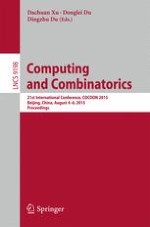2015 | OriginalPaper | Buchkapitel
Unique Covering Problems with Geometric Sets
verfasst von : Pradeesha Ashok, Sudeshna Kolay, Neeldhara Misra, Saket Saurabh
Erschienen in: Computing and Combinatorics
Aktivieren Sie unsere intelligente Suche, um passende Fachinhalte oder Patente zu finden.
Wählen Sie Textabschnitte aus um mit Künstlicher Intelligenz passenden Patente zu finden. powered by
Markieren Sie Textabschnitte, um KI-gestützt weitere passende Inhalte zu finden. powered by
The
Exact Cover
problem takes a universe
U
of
n
elements, a family
$$\mathcal F $$
F
of
m
subsets of
U
and a positive integer
k
, and decides whether there exists a subfamily(set cover)
$$\mathcal F '$$
F
′
of size at most
k
such that each element is covered by exactly one set. The
Unique Cover
problem also takes the same input and decides whether there is a subfamily
$$\mathcal F ' \subseteq \mathcal F $$
F
′
⊆
F
such that at least
k
of the elements
$$\mathcal F '$$
F
′
covers are covered uniquely(by exactly one set). Both these problems are known to be NP-complete. In the parameterized setting, when parameterized by
k
,
Exact Cover
is W[1]-hard. While
Unique Cover
is FPT under the same parameter, it is known to not admit a polynomial kernel under standard complexity-theoretic assumptions.
In this paper, we investigate these two problems under the assumption that every set satisfies a given geometric property
$$\Pi $$
Π
. Specifically, we consider the universe to be a set of
n
points in a real space
$${\mathbb R}^d$$
R
d
,
d
being a positive integer. When
$$d = 2$$
d
=
2
we consider the problem when
$$\Pi $$
Π
requires all sets to be unit squares or lines. When
$$d >2$$
d
>
2
, we consider the problem where
$$\Pi $$
Π
requires all sets to be hyperplanes in
$${\mathbb R}^d$$
R
d
. These special versions of the problems are also known to be NP-complete. When parameterizing by
k
, the
Unique Cover
problem has a polynomial size kernel for all the above geometric versions. The
Exact Cover
problem turns out to be W[1]-hard for squares, but FPT for lines and hyperplanes. Further, we also consider the
Unique Set Cover
problem, which takes the same input and decides whether there is a set cover which covers at least
k
elements uniquely. To the best of our knowledge, this is a new problem, and we show that it is NP-complete (even for the case of lines). In fact, the problem turns out to be W[1]-hard in the abstract setting, when parameterized by
k
. However, when we restrict ourselves to the lines and hyperplanes versions, we obtain FPT algorithms.
